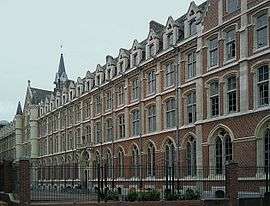Lille Catholic University
University and Polytechnic Federation of Lille[3] (French: Fédération Universitaire et Polytechnique de Lille), which also goes by the name Lille Catholic University (French: Université Catholique de Lille) ("Catho"), is a private federation of Catholic-inspired institutions established in 1973.[4] Its history dates back to 1875 when the first of these institutions was created. The Federation comprises five faculties, 20 schools and institutes, research centers, and a hospital, with a cumulative student body of 24,540 in 2012. It should not be confused with the University of Lille.
Université Catholique de Lille | |
| Motto | In fide ad scientam In faith, to knowledge |
|---|---|
| Type | Private |
| Established | 28 October 1875 (145 years ago)[1] |
| Chancellor | Lawrence Ulrich |
| President-Rector | Pierre Giorgini (2012–2017)[2] |
Academic staff | 1000 permanent 2500 visiting |
| Students | 25,500 (2010–2011)[2] |
| Location | , , |
| Campus | Urban (10ha) |
| Founder | Philibert Vrau |
| Website | univ-catholille.fr |

History
The year of the Wallon Law of 12 July 1875 freeing up higher education, the Catholic University of Lille was founded by a committee of lay Ultramontanes[5] including Philibert Vrau, "embarrassed" by the absence of such a structure in Lille while public schools were established in Lille since 1854. This was amidst a national debate on secularism before the church-state separation in France.
The Faculty of Medicine was created in 1876[6] and the College of Theology in 1877.[7] The official inauguration took place on 15 January 1877, upon receipt of the papal bull which gave the Lille Catholic University canonical status.
A new law on 19 March 1880 provided funding for private institutions of higher education, but denied them the use of the term "university".[8] The young "free university" became officially the Lille Catholic Institute. In 1973, Lille and Polytechnic University Federation was created, bringing together some forty private institutions of higher education.[9] Although a section of the Education Code prohibits the use of the term university by private institutions,[10] it is still called Lille Catholic University,[9][11] in France and abroad.[12]
Coat of arms
The coat of arms was developed during the founding period, the 1870s. It highlights the institution's academic and ecclesial character, the tradition in which it is rooted, and the part played by the two northern provinces in its creation. It has four sections.
- The first offers a gules field with two keys in saltire: these are the weapons of the ancient Collège Saint-Pierre de Lille and Lille Cathedral, which represented the university's origins and union with the Chair of Peter.
- The second section is an ermine field with open book, distinguishing symbols of the science doctorate.
- The third section represents the Lion of Flanders.
- The fourth is a recent change, the starry flag of the European Union.
Structure
Catho includes:[13]
- Lille Catholic Institute (ICL), a private institute of higher education with five faculties;
- twenty schools and institutes, with the engineering schools HEI, ICAM, ISA, ISEN;
- 3 transversal institutes;[14][15]
- a hospital group, the Hospital Group at UCL (GHICL), the CMP Cross;
- about 40 research teams (400 research professors and 140 PhD students);
- Vauban University Library, created in partnership with EDHEC, the Espeme, the IÉSEG, the FLSEG, the FLSH, and FLD, 12 area libraries, a digital library network (BNR);
- a sports center of 7 hectors, established at Ennetières-en-Weppes.
Its campus, which covers 10 hectares in the city, includes 2000 student rooms on campus, chaplaincy, and a cultural center.
The Catho is chaired by Pierre Giorgini since July 2012.[16] His administration is composed of several boards and commissions: the University Council, Supervisory Board, and the board including the bishops of Arras, Cambrai, and Lille. There are also five Advisory Committees, (e.g., the Cultural Commission).
The federation has 25,500 students in 2014 (including 6500 in faculties) with more than 2600 international students, from at least 120 different countries.[17] Overall, this corresponds to 4500 graduates per year, including 635 engineers. The teaching staff consists of 1,000 permanent and 2,500 temporary lecturers.
Catho is a founding member of the COMUE (Commonwealth of Universities and Institutions of Lille Nord de France), University of Lille Nord de France.
The areas of study are Law, Economics, Management; Science and Technology; Arts, Humanities, Theology and Religious Studies, Ethics; Health and Social Care. The faculties are FD, the Faculty of Law; FMM, The Faculty of Medicine and Maieutics;[18] GHEF, the Faculty of Business, Economics, and Sciences; FLSH, the Faculty of Arts and Humanities; FT, the Faculty of Theology.
Schools and institutes
Law, economics, management
Science and technology
Humanities & theology
Education and training
|
Health and welfare
Associated high schools
|
Research
In 2014, the research activity of the Catholic University of Lille included nearly 440 teachers and researchers and 130 doctoral students (enrolled in the PhD Doctoral Schools Public University), which corresponds approximately to 240 ETP research. This workforce is spread over fifty research units in disciplines as diverse as nanoscience, psychology, economics, law, or theology. Some Catho research units are labeled and carried under joint supervision with public universities. These are of two mixed units: CNRS (LEM[20] - UMR 8179, IEMN[21] - UMR 8520) and two host teams (EA - LGCgE,[22] EA - L2EP[23]). There is also a Clinical Research Center.[24] And the medical school maintains a center for Economic Geology, Jardin botanique Nicolas Boulay.
For about ten years, Lille Catholic University institutions worked at structuring and strengthening their research activity. At the federation level, this focused on the organization of research, with the appointment of a Vice-president for Research – Cailliez Jean-Charles (2003–2012) and Nicolas Vaillant (2012 - ) – and the creation of a research council of the University. This organization induced structuring of research areas covered by the centers and the faculty of the federation, fostering the emergence of major cross-cutting themes. They share concern for the betterment of life in contemporary society: responsibilities and risks; ethics, care, and loss of autonomy; energy, housing, environment, and sustainable development; innovation, collective intelligence, and new human interactions.
Student life

Associations
Student Federation
The Federation of Lille Catholic University students (or FEUCL)[25] created in 1926 coordinates the 300 campus organizations and represents 17,000 students in the assemblies of Catho at CROUS[26] or FAGE.[27]
Association of University Support
The Association of University Support (AEU)[28] manages 10 residences and Meurein restaurant serving 5000 meals a day, lunch and dinner. In addition, the Meurein restaurant has a cafeteria open to students and teachers most of the day. The AEU has been created and is administered by the FEUCL.
Internal associations in schools and faculties
Most schools and faculties have a student office (BDE) or a corporation that deals with both solidarity and culture. BDE and corporations represent their school or faculty to FEUCL. For example, ACEM (Corporate Association of Medical Students), created in 1910, lays claim to being the oldest French student corporation. In addition to the BDE and corporations, schools and faculties of Catho include associations for sports and for humanitarian, cultural, and festive events.
Activities
Students have access to sports activities through the center of Ennetières-en-Weppes of Catho or the gyms of the AEU. The university also has a cultural facility that arranges lectures, public debates, special meetings, and cultural exhibits. One of the buildings also houses a showroom. In addition to the restaurant Meurein, there's a sandwich shop, Vauban. Also, the bars and clubs of Lille, in particular in the Massena district and Henninot room, almost daily receive student parties organized by the BDE or other associations.
Housing
The AEU maintains 10 residences for students. Many students live together in the Vauban quarter or the Old Lille, giving that area of the Catho a high concentration of students and low median age.
The Foundation of the Catholic University of Lille
The Foundation of the Catholic University of Lille was created under the aegis of the Fondation de France to support the general activities of the University: support for teaching and research, support of students, and heritage restoration. The foundation also awards scholarships and supports solidarity projects run by students.
References
- History
- Welcome
- The official name is attested by the statutes of the PRES Archived 24 February 2014 at the Wayback Machine of which Catho is an associate member.
- Inauguration of a new branch HEI: "Although funded with public money, it remains Catholic with Bishop Ulrich, Archbishop of Lille, blessing the Irene-Devos space." Archived 7 March 2016 at the Wayback Machine
- It brought together three faculties: Law (founded by Gabriel de Vareilles-Sommières, with lawyers like Henri-Constant Groussau), Letters, and Sciences. This fulfilled the condition to be called a "free university" as stipulated in Article 5 of the Walloon law.
- "Medicine". Archived from the original on 19 January 2016. Retrieved 24 January 2016.
- Theology
- This prohibition of using the university name now appears in Article L731-14 of the Code of Education - Education Code, Article L731-14 of Law.
- Structure Archived 23 May 2016 at the Wayback Machine of the Catholic University of Lille, on its official website
- The Education Code, Article L731-14 provides that "private higher education institutions cannpt in any case take the title of universities.... A head of an institution giving it the title of university, or awarding certificates bearing the title of Bachelor, Licentiate, or Doctorate, is punishable by a fine of €30,000."
- For instances, Lille Catholic University was the name on its website.
- In English Archived 15 August 2010 at the Wayback Machine Its name translates as Lille Catholic University.
- Presentation Archived 15 August 2010 at the Wayback Machine on its official website.
- Tranversaux Archived 26 November 2016 at the Wayback Machine
- "Transversal"
- Giorgini
- "Lille Catholic University : General informations | Faculté des Lettres et Sciences Humaines-Lille". www.flsh.fr. Retrieved 2 April 2020.
- History of free Lille Faculty of Medicine
- EDHEC
- LEM Archived 1 May 2017 at the Wayback Machine
- IEMN Archived 29 March 2016 at the Wayback Machine
- LGCgE
- L2EP
- Clinical Research Center Archived 5 March 2016 at the Wayback Machine
- Student clubs
- CROUS
- FAGE
- AEU
Further reading
- Catherine Masson La Catho. "A Century of History of the Catholic University of Lille, 1877-1977" in History and Civilization. University Press of the North: Villeneuve d'Ascq, January 2011.
- List of modern universities in Europe (1801–1945)